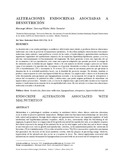Mostrar el registro sencillo del ítem
Alteraciones endocrinas asociadas a desnutrición
| dc.rights.license | http://creativecommons.org/licenses/by-nc-sa/3.0/ve/ | es_VE |
| dc.contributor.author | Abbate León, Mariangel | |
| dc.contributor.author | Villalta Gómez, Darwing | |
| dc.contributor.author | Camacho, Nolis | |
| dc.date.accessioned | 2019-06-17T14:51:22Z | |
| dc.date.available | 2019-06-17T14:51:22Z | |
| dc.date.issued | 2019-06-17 | |
| dc.identifier.issn | ISSN:1690-3110 | |
| dc.identifier.uri | http://www.saber.ula.ve/handle/123456789/45832 | |
| dc.description.abstract | La desnutrición es un estado patológico secundario a déficit nutricional, donde se producen diversas alteraciones endocrinas con el fin de preservar la homeostasis metabólica. Se describen múltiples interrelaciones funcionales endocrinas, tanto centrales como periféricas, a través de las cuales, el tejido adiposo y gastrointestinal constituyen importantes reguladores del metabolismo corporal y de las respuestas hipotálamo-hipofisarias, quienes, a su vez, adecúan convenientemente el funcionamiento del organismo. En líneas generales ocurre una supresión del eje de crecimiento y del eje reproductivo, esto como una respuesta adaptativa que permite preservar la energía de los nutrientes para su utilización por órganos vitales y de esta manera no derivar energía a procesos no vitales como el crecimiento y la reproducción. Así mismo, en el paciente desnutrido se reduce la conversión de tiroxina (T4) a triyodotironina (T3) e incrementa la T3 reversa (T3 r) como un mecanismo protector que garantiza la disminución de la actividad metabólica basal, con la finalidad de preservar energía. No obstante, también se produce como respuesta al estrés una hiperactividad del eje adrenal. Las implicaciones clínicas en la desnutrición están determinadas principalmente por hipogonadismo asociado a un incremento del riesgo de osteoporosis y retraso del crecimiento y la pubertad en niños y adolescentes, que puede originar problemas de autoestima con implicaciones psicosociales. Aunado a esto, el exceso de adiponectina y glucocorticoides inciden en la respuesta inmune y condicionan un incremento de la susceptibilidad infecciosa. En este artículo se revisan estas alteraciones endocrinas asociadas a desnutrición. | es_VE |
| dc.language | Español | |
| dc.language.iso | es | es_VE |
| dc.publisher | SaberULA | es_VE |
| dc.rights | info:eu-repo/semantics/openAccess | es_VE |
| dc.subject | Desnutrición | es_VE |
| dc.subject | Alteraciones endocrinas | es_VE |
| dc.subject | Hipogonadismo | es_VE |
| dc.subject | Osteoporosis | es_VE |
| dc.subject | Hiperactividad adrenal | es_VE |
| dc.title | Alteraciones endocrinas asociadas a desnutrición | es_VE |
| dc.title.alternative | Endocrine alterations associated with malnutrition | es_VE |
| dc.type | info:eu-repo/semantics/article | es_VE |
| dcterms.dateAccepted | Diciembre 2018 | |
| dcterms.dateSubmitted | Septiembre 2018 | |
| dc.description.abstract1 | Malnutrition is a pathological condition secondary to nutritional defi cit, where diverse endocrine alterations occur in order to preserve metabolic homeostasis. Multiple endocrine functional interrelationships are described, both central and peripheral, through which adipose and gastrointestinal tissues are important regulators of body metabolism and hypothalamic-pituitary responses, which, in turn, conveniently adapt the functioning of the organism. In general, there is a suppression of the growth axis and of the reproductive axis, as an adaptive response that allows to preserve the energy of the nutrients for its use by vital organs, and in this way, not to derive energy to non-vital processes such as growth and reproduction. Likewise, in the malnourished patient, the conversion of thyroxine (T4) to triiodothyronine (T3) is reduced and the reverse T3(rT3) is increased as a protective mechanism that guarantees the decrease of the basal metabolic activity, with the purpose of preserving energy. However, hyperactivity of the adrenal axis also occurs as a response to stress. The clinical implications associated with malnutrition are mainly determined by hypogonadism associated with an increased risk of osteoporosis and retardation and puberty in children and adolescents, which can lead to self-esteem problems with psychosocial implications. Added to this, the excess of adiponectin and glucocorticoids affect the immune response and condition an increase in infectious susceptibility. In this article we review the endocrine disorders associated with malnutrition. | es_VE |
| dc.description.colacion | 18-25 | es_VE |
| dc.description.email | mariangelabbate85@gmail.com | es_VE |
| dc.description.email | darwingvillalta@hotmail.com | es_VE |
| dc.description.frecuencia | Cuatrimestral | |
| dc.description.paginaweb | http://www.saber.ula.ve/rvem/ | |
| dc.identifier.depositolegal | ppi. 200902ME4351 | |
| dc.subject.institucion | Universidad de Los Andes | es_VE |
| dc.subject.keywords | Malnutrition | es_VE |
| dc.subject.keywords | Endocrine disorders | es_VE |
| dc.subject.keywords | Hypogonadism | es_VE |
| dc.subject.keywords | Osteoporosis | es_VE |
| dc.subject.keywords | Adrenal hyperactivity | es_VE |
| dc.subject.pais | Venezuela | |
| dc.subject.seccion | Revista Venezolana de Endocrinología y Metabolismo: Revisiones | es_VE |
| dc.subject.tipo | Artículos | es_VE |
| dc.subject.unidadinv | 1)Unidad de Endocrinología. 2)Servicio de Nutrición, Crecimiento y Desarrollo Infantil, Instituto Autónomo Hospital Universitario de los Andes (IAHULA)-Universidad de Los Andes. Mérida, Venezuela. | |
| dc.type.media | Texto | es_VE |
Ficheros en el ítem
Este ítem aparece en la(s) siguiente(s) colección(ones)
-
Revista Venezolana de Endocrinología y Metabolismo. Vol. 17 Nº 1
Enero-Abril 2019


